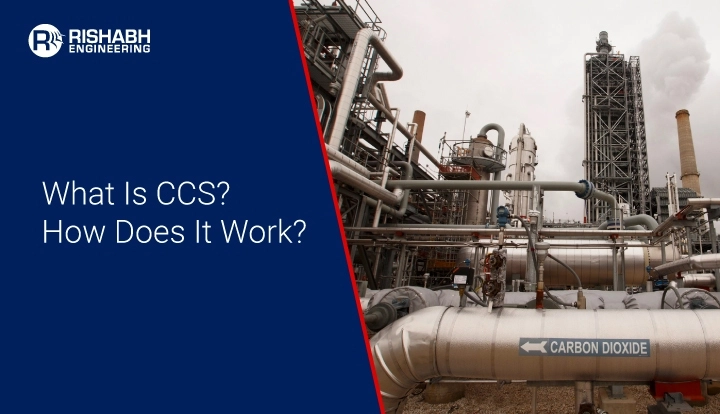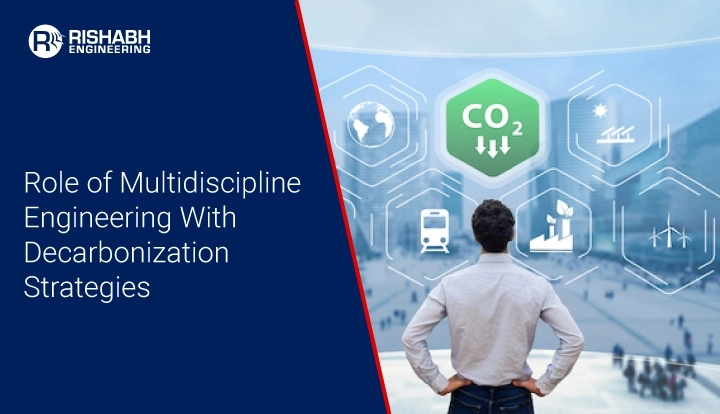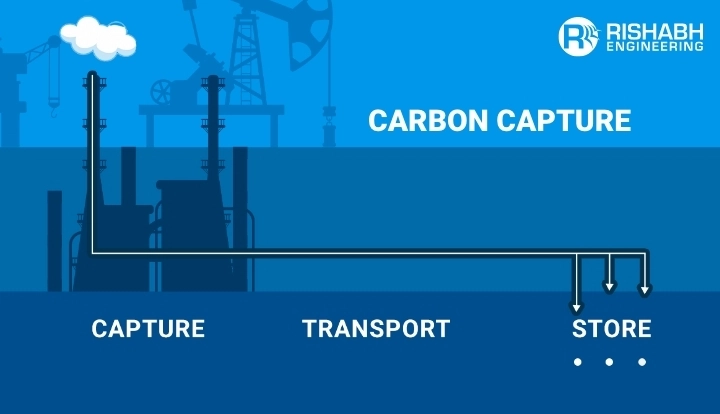
What is Carbon Capture and Storage (CCS) and How Does It Work?
Carbon Capture and Storage (CCS) refers to the mitigation of carbon emissions from large point sources such as power plants, refineries and other industrial facilities, or the removal of existing CO2 from the atmosphere. Today, it is considered as the key to addressing global warming while dealing with climate change. In this article, we’ll attempt to explain the concept of CCS, how it works, its potential benefits, and how companies like Rishabh Engineering can work with organizations to reduce this impact.

What is Carbon Capture and Storage (CCS)?
CCS involves capturing Carbon Dioxide (CO2) at emission sources and transporting, storing, or burying it in a suitable deep, underground location. It refers to taking out CO2 directly or indirectly from the atmosphere. You might wonder why dealing with these emissions head-on is crucial. Well, to answer your question, as we cut down trees and burn more fuel, we’re unleashing hefty amounts of CO2 into the air, which is unsuitable for the planet. Therefore, CCS is one of the critical processes to address that.
How does CCS work?
Carbon Capture And Storage (CCS) is typically a three-step process; it starts with capturing the carbon dioxide produced by power generation or industrial activity, then transporting it, and finally storing it deep underground.
Though it is classified into three steps, in reality, it could also be a complex process. We’ve attempted to elaborate on three main stages: capture, transport, and storage, as listed below;
1. Carbon Capture: As the name suggests, in this phase, we capture CO2 emissions at the source just before they are released into the atmosphere.
Listed below are the three commonly applied methodologies for CO2 capture:
- Pre-combustion capture: This method involves converting fossil fuels into a synthetic gas mainly composed of hydrogen (H2) and CO2 before combustion. The CO2 is then separated from the gas, resulting in a concentrated stream of CO2 suitable for storage. It is primarily put to work in power plants and industrial facilities.
- Post-combustion capture: CO2 is captured after combustion in this approach. Industrial flue gases are passed through a capture medium that binds with the CO2, allowing it to be separated and stored.
- Oxy-fuel combustion: This method involves burning fossil fuels in an environment enriched with pure oxygen (O2), which produces a concentrated stream of CO2 and water vapor. The water vapor is condensed, leaving behind the CO2 for capture.
2. Carbon Transport: After capturing the gas, CO2 is transported via pipelines, ships, or trucks, depending on the proximity between the capture source and the storage site. In our experience, pipelines are the most common and cost-effective transportation mode for large-scale projects.
3. Carbon Storage: This stage focuses on securing the captured CO2. Further, it involves several storage methods, as listed below:
- Geological Storage: It involves injecting the CO2 deep underground into geological formations, such as depleted oil and gas reservoirs, saline aquifers, and unmendable coal seams. These formations act as natural traps, preventing the CO2 from escaping.
- Ocean Storage: As the name suggests, it involves storing CO2 in the deep ocean. However, this method raises environmental concerns, as it may impact marine ecosystems and biodiversity.
- Mineralization: Some projects focus on converting CO2 into stable mineral compounds through a process known as mineralization. This method offers a long-term storage solution, as the CO2 is permanently sequestered in solid form.
Benefits Of Carbon Capture And Storage (CCS)
CCS technology offers numerous advantages as it plays a strategic role in global decarbonization efforts as listed below:
- Emission Reduction: CCS technology can significantly reduce CO2 emissions from industrial sources, helping countries meet their emissions reduction targets.
- Carbon Neutrality: CCS can enable the continued use of fossil fuels while achieving carbon neutrality by capturing and storing emissions.
- Renewable Energy Backup: Carbon capture and storage can be a backup for intermittent renewable energy sources, ensuring a stable energy supply during periods of low renewable energy generation.
- Industrial Decarbonization: CCS offers a solution for decarbonizing hard-to-abate industrial sectors like steel, cement, and chemicals.
- Climate Mitigation: CCS technology can play a vital role in mitigating climate change by reducing atmospheric CO2 levels.
CCS Technology Challenges and Concerns
While carbon capture and storage technology present a promising solution to the climate crisis, it also poses specific challenges and concerns.
- Energy Consumption: The carbon capture process consumes energy, reducing power plants and industrial facilities’ overall energy efficiency. It can lead to increased energy costs and potentially impact the economics of CCS projects.
- Cost: Implementing CCS technologies can be expensive. The construction of capture facilities, transportation infrastructure, and storage sites requires significant investment.
- Leakage Risk: CO2 leakage from storage sites is always a risk that can have severe environmental and safety consequences. Ensuring the integrity of storage sites is of paramount importance.
- Public Perception: Public acceptance of CCS projects can be challenging, as there are concerns about the safety of underground storage and the potential for displacing local communities.
Real-World Applications of Carbon Capture and Storage
Listed below are some of the examples of global carbon capture and storage projects;
- Petra Nova Project (USA): In Texas, this project captures CO2 emissions from a coal-fired power plant and injects the CO2 into an oil field for enhanced oil recovery.
- Sleipner Project (Norway): Operated by Equinor, this project has been storing CO2 in a saline aquifer beneath the North Sea since 1996. It serves as a pioneering example of long-term geological storage.
- Boundary Dam Project (Canada): This project in Saskatchewan captures CO2 emissions from a coal-fired power plant and transports the CO2 via pipeline to oil fields for enhanced oil recovery.
- Gorgon Project (Australia): The Gorgon natural gas project incorporates CCS by capturing CO2 from its gas processing facilities and storing it underground.
How Rishabh Engineering Can Help With CCS?
As an experienced multidiscipline engineering company, we’re involved in critical carbon capture and storage processes across design, engineering, and project management phases.
Listed below are some of the services we offer:
- Feasibility Studies: Assessing the technical and economic feasibility of implementing CCS in a specific project or facility.
- Engineering Design: Develop detailed implementation plans for CCS infrastructure, including capture technologies, transport, and storage facilities.
- Project Management: Overseeing the entire CCS project, ensuring it meets regulatory requirements and is completed within budget and on schedule.
- Technology Integration: Incorporating CCS technologies into existing industrial processes or designing new processes to accommodate carbon capture.
- Risk Assessment: Identifying and mitigating potential risks associated with CCS projects, including safety and environmental considerations.
- Compliance and Regulatory Support: Assisting in navigating regulatory requirements and ensuring compliance with environmental standards.
The Future of CCS
As discussed above, carbon capture and storage (CCS) holds promise in curbing greenhouse gas emissions while addressing the challenges of climate change. And we are witnessing governments, industries, and research organizations actively investing in advancing CCS technologies to make them more efficient and economically viable. As we strive towards a future, we can anticipate CCS to assume a role in minimizing the adverse effects of climate change.
Looking to Unlock the Power of Carbon Capture and Storage?
Our specialist engineering solutions can help you optimize efficiency, reduce emissions, and lead sustainability.

